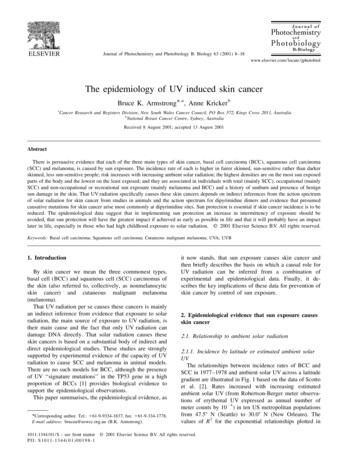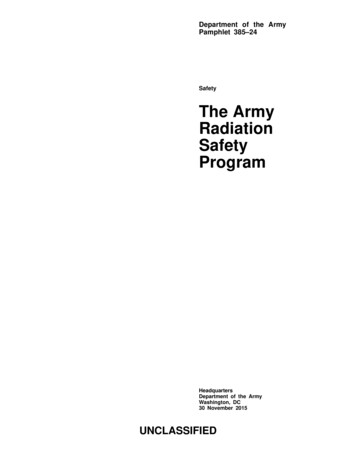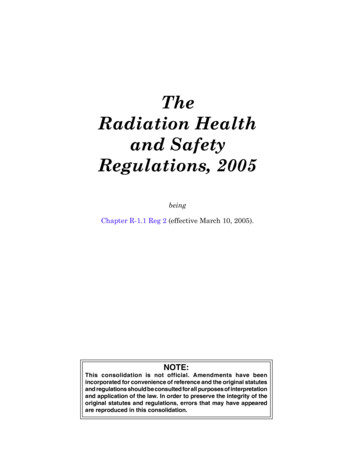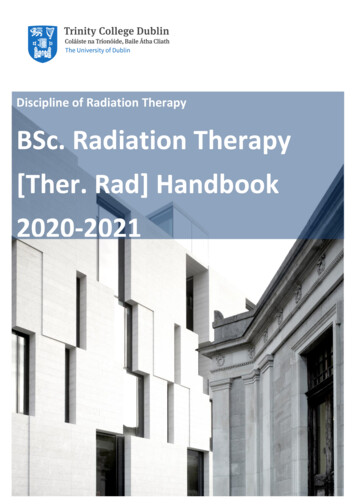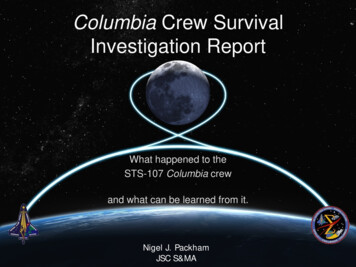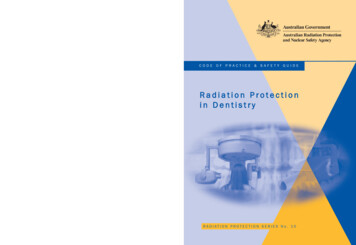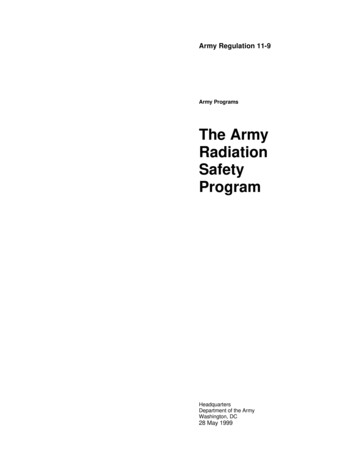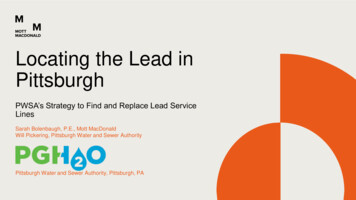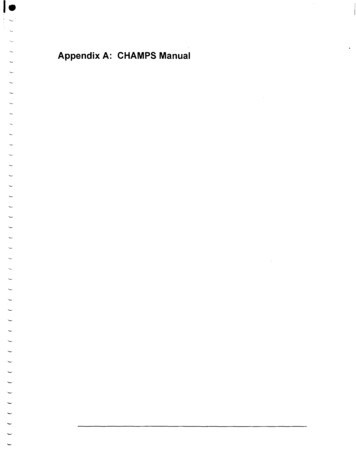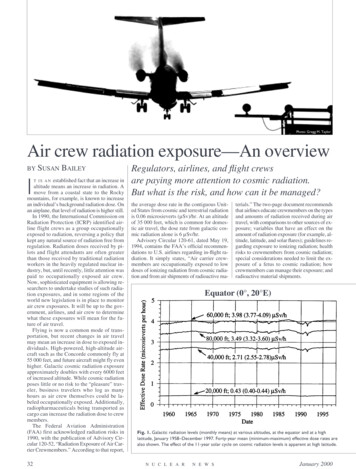
Transcription
Photo: Gregg M. TaylorAir crew radiation exposure—An overviewBY SUSANBAILEYestablished fact that an increase inaltitude means an increase in radiation. Amove from a coastal state to the Rockymountains, for example, is known to increasean individual’s background radiation dose. Onan airplane, that level of radiation is higher still.In 1990, the International Commission onRadiation Protection (ICRP) identified airline flight crews as a group occupationallyexposed to radiation, reversing a policy thatkept any natural source of radiation free fromregulation. Radiation doses received by pilots and flight attendants are often greaterthan those received by traditional radiationworkers in the heavily regulated nuclear industry, but, until recently, little attention waspaid to occupationally exposed air crew.Now, sophisticated equipment is allowing researchers to undertake studies of such radiation exposures, and in some regions of theworld new legislation is in place to monitorair crew exposures. It will be up to the government, airlines, and air crew to determinewhat these exposures will mean for the future of air travel.Flying is now a common mode of transportation, but recent changes in air travelmay mean an increase in dose to exposed individuals. High-powered, high-altitude aircraft such as the Concorde commonly fly at55 000 feet, and future aircraft might fly evenhigher. Galactic cosmic radiation exposureapproximately doubles with every 6000 feetof increased altitude. While cosmic radiationposes little or no risk to the “pleasure” traveler, business travelers who log as manyhours as air crew themselves could be labeled occupationally exposed. Additionally,radiopharmaceuticals being transported ascargo can increase the radiation dose to crewmembers.The Federal Aviation Administration(FAA) first acknowledged radiation risks in1990, with the publication of Advisory Circular 120-52, “Radiation Exposure of Air Carrier Crewmembers.” According to that report,I32T IS ANRegulators, airlines, and flight crewsare paying more attention to cosmic radiation.But what is the risk, and how can it be managed?the average dose rate in the contiguous United States from cosmic and terrestrial radiationis 0.06 microsieverts (µSv)/hr. At an altitudeof 35 000 feet, which is common for domestic air travel, the dose rate from galactic cosmic radiation alone is 6 µSv/hr.Advisory Circular 120-61, dated May 19,1994, contains the FAA’s official recommendations to U.S. airlines regarding in-flight radiation. It simply states, “Air carrier crewmembers are occupationally exposed to lowdoses of ionizing radiation from cosmic radiation and from air shipments of radioactive ma-terials.” The two-page document recommendsthat airlines educate crewmembers on the typesand amounts of radiation received during airtravel, with comparisons to other sources of exposure; variables that have an effect on theamount of radiation exposure (for example, altitude, latitude, and solar flares); guidelines regarding exposure to ionizing radiation; healthrisks to crewmembers from cosmic radiation;special considerations needed to limit the exposure of a fetus to cosmic radiation; howcrewmembers can manage their exposure; andradioactive material shipments.Equator (0 , 20 E)Fig. 1. Galactic radiation levels (monthly means) at various altitudes, at the equator and at a highlatitude, January 1958–December 1997. Forty-year mean (minimum-maximum) effective dose rates arealso shown. The effect of the 11-year solar cycle on cosmic radiation levels is apparent at high latitude.N U C L E A RN E W SJanuary 2000
Equator (0 , 20 E)High Latitude (70 N, 20 E)Fig. 2. Percent contributions to the mean effective dose rate of galactic radiation by its components as related to altitude, at the equator and at a highlatitude, January 1958–December 1997 (Source: W. Friedberg, et al., ibid. Reproduced with permission from Nuclear Technology Publishing.)What exactly is it?Ionizing radiation particles (mostly protonsand alpha particles) enter Earth’s atmosphere,where they collide with nitrogen, oxygen, andother atoms, breaking apart their nuclei. Boththe charged particles entering the solar system and the secondary radiation they producein the atmosphere are referred to collectivelyas galactic cosmic radiation. Each disruptednucleus can itself yield multiple ionizing particles, which can interact with other nucleiand produce still more particles, until, afterseveral interactions, they have lost the energy to cause disruptions. The sun is also a considerable source of radiation; solar radiationand galactic cosmic radiation are commonlyreferred to jointly as cosmic radiation.Wallace Friedberg, team leader of the radiobiology research group at the FAA’s Civil Aeromedical Institute (CAMI) in OklahomaCity, Okla., explainedin a 1998 meeting paper that the effect ofgalactic cosmic radiation generally declineswith decreasing altitude. Radiation levelsare also lower near theequator than towardthe north and southpoles, Friedberg explained, because theFriedbergEarth’s magnetic fielddeflects incoming galactic cosmic radiationparticles (particularly those with low energy).The effect of the Earth’s magnetic field isgreatest at the geomagnetic equator, which islocated near the geographic equator. Fromdata gathered during January 1958–December 1997, Friedberg was able to estimate thatHigh Latitude (70 N, 20 E)(Source: W. Friedberg, et al. Reproduced from Cosmic Radiation and Aircrew Exposure, pp. 323–328, withpermission from Nuclear Technology Publishing, P.O. Box 7, Ashford, Kent TN23 1YW, England.)January 2000N U C L E A RN E W San airplane at an altitude of 20 000 feet at 70 North latitude (near the Arctic circle) wouldreceive galactic cosmic radiation a factor of2.0 higher than at the same altitude at theequator (see Fig. 1). He presented the paper,“Guidelines and Technical Information Provided by the U.S. Federal Aviation Administration to Promote Radiation Safety for AirCarrier Crewmembers,” at the InternationalConference on Cosmic Radiation and AircrewExposure, Implementation of European Requirements in Civil Aviation, on July 1–3,1998, in Dublin, Ireland.At every latitude, the altitude at which thedose rate is highest is different. The initial interaction of galactic cosmic radiation with theEarth’s atmosphere can be so intense that aunique phenomenon is observed at high altitudes above the equator: The intensity of theradiation is lower at 80 000 feet than at 60 000feet, where particle interactions reach theirpeak.Friedberg was able to identify the particlesresponsible for the galactic cosmic radiationdose to an aircraft cruising at typical altitudesof 20 000–40 000 feet. At that altitude, andover his 40-year study period, 88–97 percentof the effective dose rate was from neutrons(33–52 percent), protons (21–28 percent), andelectrons and photons (17–41 percent) (seeFig. 2). Muons contribute 2–11 percent, andcharged pions less than 1 percent.Cosmic radiation levels are never constant.Researchers have been taking measurementsfor nearly 50 years, and have identified an 11year cycle of galactic cosmic radiation intensity, which is influenced by the sun’s activity. Solar particle events (SPEs), also knownas solar flares, can occur at any time, but occur more frequently during a few years of thatcycle, known as solar maximum. When thebasic dipole component of the sun’s continually varying magnetic field reverses direction,solar minimum is reached, and SPEs are infrequent and less powerful.The solar wind (a plasma of solar radiation—mostly protons and electrons—ejectedfrom the sun) carries a convoluted magneticfield throughout the solar system. This wind33
AIR CREW RADIATION EXPOSUREcontains more irregularities at solar maximum, which makes the magnetic field changeand become unusually tortuous and strong.Since the ionized particles making up galacticradiation are electrically charged, they can beaffected by the highly ionized particles in thesolar wind. “Irregularities in the magneticfields carried by the solar winds scatter thelow-energy galactic particles that would otherwise enter the Earth’s atmosphere,” Friedberg told Nuclear News. Because of this,galactic cosmic radiation is at a minimum during solar maximum, but during solar minimum, more of that radiation can reach theEarth. The most recent solar minimum occurred in early 1997, and solar maximum isexpected to begin ahead of schedule in May2000, according to Friedberg.SPEs are usually too low in energy to contribute to radiation levels at the altitudes commonly reached by a standard airplane. Occasionally, however, during solar maximum, thenumbers and energies of these solar radiationparticles increase enough to affect the cosmicradiation dose to air travelers. SPEs are shortlived: They commonly rise to a peak radiationlevel and then drop to near normal levels within two–three hours. Figure 3 illustrates solarproton levels, as measured by the NationalOceanic and Atmospheric Administration’sSpace Environment Center, on November 7,1997, when a measurable solar flare occurred(Fig. 4, by contrast, shows typical solar protonlevels).The strongest SPE ever recorded occurredon February 23, 1956. At the time, no measurements of cosmic radiation at high altitudescould be made, and researchers have usedmodels to estimate the dose that a person flying at a high altitude during the SPE wouldhave received. Paul Goldhagen, a physicistwith the Department of Energy’s Environmental Measurements Laboratory, in NewYork, N.Y., explained that researchers haveperformed extrapolations to determine that anSPE with the strength of the 1956 event couldmean a dose equivalent of more than 10 millisieverts (mSv)/h to the passengers and crewof a high-latitude supersonic flight.SPEs could have more of an effect on future high-flying jets. A hypothetical supersonic transport (SST) would contain an onboard radiation monitor, as the Concorde doesnow, that could warn pilots of the onset of anSPE if air traffic controllers were not able todo so. If this monitor indicated an SPE wasoccurring, the plane could evade the radiationby lowering its altitude from 65 000 feet to approximately 45 000 feet, or by moving to alower latitude. “That’s fine when you haveone plane flying,” said Goldhagen. “If you’vegot a hundred SSTs in the year 2050, it’s suddenly more dangerous for them all to try to godown to a lower altitude at once than it is to sitthere and accept the radiation.” By that time,he theorizes, it may be possible to predictwhen an SPE is likely.An SPE could also affect the SST of thefuture by interfering with the avionics onboard. A single event upset, or SEU, couldoccur if ionizing radiation damages a computer chip, and could put the aircraft in jeop-34Fig. 3. Data acquired during the solar particle event of November 4–7, 1997, by the GEOS-9 satellite,showing the intensity of solar protons in three energy ranges ( 10 MeV, 50 MeV, and 100 MeV)(Source: NOAA)Fig. 4. Data acquired under normal solar conditions, by the GEOS-9 satellite, showing the intensity ofsolar protons in three energy ranges ( 10 MeV, 50 MeV, and 100 MeV) (Source: NOAA)ardy. It is possible, Goldhagen theorizes, thatif no steps are taken to prevent radiation fromupsetting avionics, the biggest health threatto passengers and crewmembers from radiation may be from resulting malfunctions inthe aircraft.How large a dose?Friedberg has developed a computer program that can estimate the galactic radiationdose received on a flight between any twoN U C L E A RN E W Sairports in the world. The latest version ofthat program, CARI-5E, is available on theWeb at www.cami.jccbi.gov/AAM-600/610/600radio.html . The program takes intoaccount the location of an airplane from takeoff to touchdown, including the altitudesreached during the flight and the time spentat each altitude, as well as latitude and longitude changes. Using the date of flight entered by the software user, CARI-5E adjustsits dose estimation to reflect the 11-year so-January 2000
TABLE I. EFFECTIVE DOSES OF GALACTIC COSMIC RADIATION RECEIVED ON AIR CARRIER FLIGHTSSingle nonstop one-way flightHighestAltitude, feetin thousandsAir time,hoursBlockhoursSeattle WA – Portland ORHouston TX – Austin TXMiami FL – Tampa FLSt. Louis MO – Tulsa OKSan Juan PR – Miami FLTampa FL – St. Louis MONew Orleans LA – San Antonio TXLos Angeles CA – Honolulu .11 – 0.15)(0.12 – 0.15)(0.28 – 0.36)(1.20 – 1.74)(4.16 – 5.18)(3.35 – 4.74)(2.54 – 3.31)(11.5 – 13.3)0.020.020.040.140.190.200.220.23Denver CO – Minneapolis MNNew York NY – San Juan PRHonolulu HI – Los Angeles CAChicago IL – New York NYLos Angeles CA – Tokyo JPTokyo JP – Los Angeles CAWashington DC – Los Angeles CANew York NY – Chicago (2.56 – 4.05)(7.52 – 10.1)(13.4 – 15.8)(4.33 – 7.10)(31.8 – 40.4)(24.6 – 32.2)(13.2 – 19.1)(5.93 – 9.85)0.240.260.270.300.320.330.340.37Minneapolis MN – New York NYLondon GB – Dallas/Ft. Worth TXLisbon ES – New York NYDallas/Ft. Worth TX – London GBSeattle WA – Anchorage AKChicago IL – San Francisco CASeattle WA – Washington DCLondon GB – New York 5.54 – 9.26)(27.6 – 45.1)(20.5 – 31.1)(24.8 – 41.4)(10.4 – 17.8)(13.2 – 19.8)(14.3 – 23.8)(23.8 – 40.0)0.380.380.400.400.410.430.460.47San Francisco CA – Chicago ILNew York NY – Seattle WANew York NY – Tokyo JPLondon GB – Los Angeles CAChicago IL – London GBTokyo JP – New York NYLondon GB – Chicago ILAthens GR – New York 58.2(14.2 – 22.1)(17.7 – 30.1)(48.3 – 77.7)(38.5 – 64.9)(26.6 – 45.8)(44.3 – 74.8)(29.6 – 51.6)(42.3 – 67.0)0.480.480.500.500.500.500.520.60Origin – DestinationabMean (minimum–maximum) effective dose, January 1958–December 1997.Based on the mean effective dose for the one-way flight.N U C L E A RMillisievertsper 100block hoursb(Source: W. Friedberg, et al., ibid. Reproduced withpermission from Nuclear Technology Publishing.)NASA ER-2 taking off. Radiation sensors for the AIR measurements were carried in the nose, thefuselage behind the cockpit, and the front third of both wing pods. (Source: DOE EnvironmentalMeasurements Laboratory, presented at the 1998 NCRP Annual Meeting, “Cosmic Radiation Exposureof Airline Crews, Passengers, and Astronauts”)36Effective dose,microsievertsaN E W Slar cycle. The program can estimate dose onany flight from January 1958 to the present,providing a useful tool for epidemiologiststrying to assess possible health effects causedby long-term cosmic radiation exposures toair crew.Table I illustrates typical mean, minimum,and maximum dose rates received on flightsover the last 40 years. According to Friedberg,a flight attendant working 700 block hours annually (measured from the time the aircraftleaves the blocks before takeoff to when itreaches the blocks after landing) flying between Athens, Greece, and New York Citywould receive an annual occupational exposure of 4.2 mSv. Friedberg explained in his paper that based on the data in the table, the average annual radiation dose to crewmembersfrom occupational and nonoccupationalsources can vary. For some, it can be close tothe amount received by the general population,and for others it can be twice that amount.At the request of the National Aeronauticsand Space Administration (NASA), the Na-January 2000
AIR CREW RADIATION EXPOSUREtional Commission on Radiation Protectionstudied radiation exposure and high-altitudeflight, and in July 1995 published Commentary 12, which recommended that “averageabsorbed dose rates and their uncertainty inthe altitude range of 30 000 to 80 000 feet require greater specification, and additionalmeasurements utilizing currently flyinghigh-altitude aircraft should be made withadequate instrumentation” to eliminate thatuncertainty.Since then, the NASA High Speed Research Project Office, working out of theagency’s Langley Research Center under thedirection of John W. Wilson, has attempted tocharacterize radiation conditions at high-altitude flight. Assisting in the mission were theDOE’s EML, NASA’s Johnson Space Center,the Canadian Defense Research Establishment and Royal Military College, GermanAerospace Research Establishment, U.K. National Radiological Protection Board, BoeingCompany, and several researchers from domestic and foreign universities.Galactic cosmic radiation measurementswere made using a converted military spyplane, the ER-2, which can reach altitudes of75 000 feet. Behind the mission, known asthe Atmospheric Ionizing Radiation (AIR)project, was the need for accurate characterization of radiation levels at the high altitudes that would be reached by a hypothetical SST.The ER-2 plane was used on a series offive missions flown from NASA’s Ames Re-54Fig. 5. Flight paths ofthe AIR measurementER-2 flights (Source:DOE EnvironmentalMeasurementsLaboratory, presentedat the 1998 NCRPAnnual Meeting, ibid.)January 2000N U C L E A RN E W S37
search Center at Moffett Field, Calif., in June1997 (during the last solar minimum), whengalactic cosmic radiation exposures could beexpected to be at their highest (see Fig. 5).Fourteen different instruments were contained within the plane, including a multisphere neutron spectrometer, ionizationchamber, and scintillation counters fromEML, two spherical tissue-equivalent proportional counters, and two particle telescopes. Data from the flights were collectedto allow further refining of the AIR model ofthe galactic cosmic radiation environment,and to permit precise dose estimates for highaltitudes.Regulators have their sayIt has been acknowledged that the radiationdoses crewmembers receive constitute occupational exposure, but should this exposure belimited? Governments worldwide are now deciding how to address the risk of radiation toair crew.In the United States, the FAA has publisheddocuments discussing air crew radiation exposure, and has issued recommendations toairlines on educating air crew about therisks—but it has not issued dose limits. U.S.airlines have not voluntarily adopted trainingor dose monitoring programs similar to thosein the nuclear power industry. Friedberg toldNuclear News that his research group atCAMI “will continue providing informationand making recommendations. We don’t haveany regulations, however, at the moment. Thatis something that may or may not happen inthe future. . . . If there is enough of a reactionin the aviation community [the FAA] mightfeel compelled to do it.”As shown in Table II, air crew typically receive more radiation exposure than radiationworkers at a nuclear facility. Most groups of“terrestrial” radiation workers include a number of people whose occupational exposure isnear zero, which lowers the average effectivedose. All air crew, however, are exposed to unavoidable radiation for the duration of a flight,so their average effective dose is relativelyhigh.According to Robert Barish, of New York,N.Y., a medical physicist and certified healthphysicist who has worked in radiation oncology, and who speaks and writes about cosmicradiation, considering that crewmembers areoccupationally exposed to radiation, “they area legitimate, regulated radiation cohort thatshould be told about the risks. Unfortunately,the airlines have never told them.” In Europe,by contrast, airlines must begin informing aircrew of their radiation doses in May 2000.The European Union’s radiation protectionpolicy is contained in the EU Directive on theprotection of workers and members of thepublic against the hazards of ionizing radiation (96/29/Euratom), which is binding on allmember states and is revised every 10–12years.The Directive generally matches ICRP recommendations, and requires that the dose received by any crewmembers who may receive more than 1 mSv per year should beassessed. In addition, airlines will be required38TABLE II. ANNUAL EXPOSURE, QUALITY OF EXPOSURE, AND RISK COEFFICIENTUNCERTAINTY OF U.S. RADIATION WORKERSGroupExposureQualityDistribution Risk uncertainty(mSv) Low LET, % High LET, %factorTerrestrial occupations 21Low earth orbit:low inclination17high inclination 144Deep icant exposures to HZE (highly charged, energetic) ions.**Exposure dominated by HZE ions(Source: NASA, presented at the 1998 NCRP Annual Meeting)to organize the schedules of crewmemberswith the objective of reducing the doses ofhighly exposed air crew, educate the crewabout health risks, and give special protections to women who have declared pregnancy. Flight attendants at British Airways, forexample, are “grounded” immediately afterdeclaring pregnancy, and are given othertasks until they take maternity leave, according to Michael Bagshaw, head of MedicalServices at the airline. Individuals who mayreceive more than 6 mSv per year may besubject to more stringent measures after May2000, such as warning signs or individualdosimetry.What do crewmembers think?The International Federation of Air Line Pilots Associations (IFALPA) is trying to makeits concern about radiation exposures known.IFALPA represents approximately 100 000pilots from pilot associations in about 90 different countries, including the United States.The organization’s Human PerformanceCommittee held a meeting in October 1998,and produced a policy proposal similar to theEU Directive that states, among other things,that long-range airplanes normally operatedabove 8000 m (26 000 ft) should carry equipment to measure and indicate continuously thedose rate of total cosmic radiation being received, the cumulative dose on each flight,and the presence of any solar flares. Allcrewmembers, the policy said, should be allowed to adjust their flying schedules so thatthey do not exceed an annual threshold limitof 6 mSv/year.The policy was approved by IFALPAmember associations at a conference held inApril 1999. Herbert Meyer, senior technicalofficer at IFALPA headquarters in the UnitedKingdom, admitted, “this issue has been thesubject of extensive debate within IFALPAand the Human Performance Committee inparticular, and as is the case in the entire scientific community, no conclusive findingshave been reached.” The policy approved inApril was revised by the IFALPA Human Performance Committee at an October 1999meeting. The revised policy, not yet approvedN U C L E A RN E W Sby the IFALPA member associations, readsas follows:“IFALPA policy recognises 20 mSv/yr asthe cosmic radiation limit for airline flightcrews as established by the National Councilof Radiation Protection and Euratom. It is further recognized that airline flight crewsshould be categorised as occupationally exposed radiation workers, likely to receivemore than 1 mSv/yr. As cosmic radiation imposes a potential health risk to airline flightcrews, it is highly recommended that national authorities make provisions for exposureassessment verification. . . . Crew membersshould be made aware through extensive educational programs that high altitude flyingexposes them to significantly higher ionisingradiation levels, with carcinogenic potential,than the general population and the scope ofradiation protection legislation. . . . Flightcrew members should be warned that radiation exposure above 1 mSv during the courseof the entire pregnancy may cause an increased risk to the fetus. Operators shouldhave provisions in place to adjust flight duties (low altitude flights that minimise exposure/ground duties) so that this limit is not exceeded after declaration of pregnancy by theflight crew member.”Emily Carter, national health coordinatorfor the Association of Professional Flight Attendants (APFA), says that most flight attendants on U.S. carriers have an “underlyingknowledge” that cosmic radiation could posea threat, but that they currently don’t feelthere is anything they can do about it. Thismay change, however. U.S. flight attendantshave the opportunity to interact with their international counterparts, and as Europeanflight attendants begin to monitor their exposures in May 2000, those from the UnitedStates might begin to wonder why they don’tget dose estimates as well, said Carter. “Theflight attendants on U.S. carriers are going tobe very angry that they’re exposed to this, butthey’re not going to want to cut down theirlifestyles,” she predicted. “They’re just going to get angrier.” Although the mitigationor monitoring of radiation doses has not beenan issue in contract negotiations betweenJanuary 2000
Artist’s conception of a manned Marsmission, by Pat Rawlings, of SAIC, forNASA. The radiation environment 70 000 ftabove the Earth is very similar to that onthe surface of Mars. (Source: NASA)Far out!lthough the ER-2 plane did not leave the Earth’s atmosphere, its datais still useful to the NASA researchers pondering a mission to Mars.According to Robert Singleterry, a research scientist at NASA’s LangleyResearch Center (LRC) who participated in the high-speed research project, the radiation environment 70 000 ft above the Earth is very similarto that on the surface of Mars.2The concept of aerial density, measured in g/cm , allows NASA researchers to make comparisons between different atmospheres, even ifthey are composed of different elements, Singleterry explained. Aerialdensity is the sum of the mass of all the matter, in this case molecules of2atmospheric gas, above any given cm area. The measurement is significant because it identifies the amount of mass between an incoming cosmic radiation particle and a planet or other object, according to Singleterry. “[The number of] molecules the cosmic ray would see as itcomes in to penetrate the atmosphere and either hit the Martian surfaceor hit the airplane would be the same,” he said.Astronauts face a greater likelihood of suffering health effects fromoccupational exposure to cosmic radiation than do air crew (see TableII). They are exposed to more radiation, and a large percentage of the radiation is high-LET (linear energy transfer) particles. If astronauts wereinadequately shielded at the time of a large solar particle event, life-threatening injuries could occur, as John Wilson, senior research scientist atLRC, explained in “Overview of Radiation Environments and Human Exposures,” a paper he presented at the 1998 NCRP Annual Meeting.NASA’s researchers cannot guess when a large SPE might happen; theymust therefore design equipment that can help astronauts withstand thelargest possible solar radiation exposure.Extensive experimentation must still be conducted, because, as Wilson told Nuclear News, “space exposures are quite different than anything that is experienced either at high altitude or on the surface [ofEarth].” Even on missions to the Moon, spacecraft receive some protection from the Earth’s magnetic field, but there will be no such protection in deep space.NASA has moved away from the traditional radiation protection practice of setting a radiation dose limit and regulating to keep exposures below that limit, Wilson said. Instead, the focus is starting to shift to controlling the excess fatal cancers astronauts could develop later in life as aresult of a deep space mission. Currently, NASA has the goal of limiting theprobability of an astronaut’s developing fatal cancer to less than 3 percent.AJanuary 2000“We’re willing to limit the risk to 3 percent,” said Wilson, “but we don’tknow how to limit it, and we don’t know what kind of shielding materialsare going to be the best way to help out.” If NASA is to achieve its officialgoal of amassing enough technical information by 2004 to make an educated decision on whether to attempt a manned mission to Mars in 2014,those problems will have to be solved soon, according to Wilson.Singleterry, a former DOE contractor, explained the difficulties of attempting to shield astronauts. While terrestrial radiation workers can limit their time near a radiation source, distance themselves from the source,and erect thick shielding, an astronaut cannot. Because any additionalweight added to a spacecraft increases its cost, NASA engineers are forcedto be creative. Aluminum, which is commonly used in spacecraft, doesnot shield people from damage as well as water or liquid hydrogen can,for example. “It’s really hard to build stuff with liquid hydrogen,” said Singleterry, “but it’s a great fuel.” If astronauts were surrounded by their liquid hydrogen fuel, they would be better protected. The effectiveness ofthat shield, however, would decrease as the mission wore on. NASA hasconsidered providing small, heavily shielded “storm shelters” onboard towhich the astronauts could retreat during an SPE.NASA must also worry about protecting equipment from single eventupsets. NASA’s existing space shuttle experiences approximately 400computer upsets during a two-week mission, according to Singleterry.For that reason, the shuttle has five redundant computers. The computers “vote” on critical decisions; any computer that has been damaged andproduces faulty information is overruled by the others. NASA is able totest the ability of some equipment to withstand tough radiation environments by irradiating it with an electron beam. “For deep space, we’re going to have to start radiating some of these parts in front of heavy, highenergy ion beams,” said Singleterry.NASA researchers currently use Brookhaven National Laboratory’s Alternating Gradient Synchrotron (AGS) to test spacesuit and spacecraft materials in high radiation environments similar to those in space. Biologistsuse the same beam to irradiate cell cultures, mice, and rats, according toSingleterry. They ar
craft such as the Concorde commonly fly at 55 000 feet, and future aircraft might fly even higher. Galactic cosmic radiation exposure approximately doubles with every 6000 feet of increased altitude. While cosmic radiation poses little or no risk to the "pleasure" trav-eler, business travelers who log as many hours as air crew themselves .
